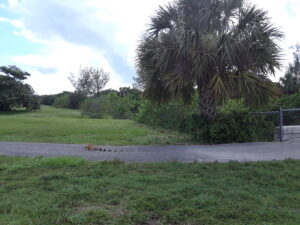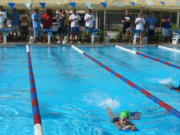
Deerfield-News.com-Deerfield Beach, Fl-Those invasive non-native nuisance Iguanas FWC says require no permit to kill. In fact, they seem to encourage property owners to do just that. We certainly have noticed the proliferation in recent years in Deerfield Beach. We know of some areas at Quiet Waters Park that flat out is infested with iguanas. We have seen many in CVE over recent years as well as all around town in Deerfield. Some of these suckers are the size of gators.
The iguana removal industry has flourished in South Florida in recent years as these critters can burrow and cause structural damage. Just do a simple Google search on Iguana removal or iguana control see how many results pop up.
Here is what the FWC says about iguanas.-
Green Iguana (Iguana iguana) – INVASIVE SPECIES
Regulatory Status
Green iguanas are not native to Florida and are considered to be an invasive species due to the damage they can cause to seawalls, sidewalks, and landscape plants. This species is not protected in Florida expect by anti-cruelty law. Homeowners do not need a permit to kill iguanas on their own property, and the FWC encourages homeowners to kill green iguanas on their own property whenever possible. Iguanas can also be killed year-round and without a permit on 22 public lands in south Florida.
Captive held iguanas are regulated as Class III wildlife in the State of Florida. A permit is not required to possess green iguanas as personal pets. However, a License to Possess Class III Wildlife for Exhibition or Public Sale must be obtained to possess these reptiles for commercial use and a Captive Wildlife Importation Permit is required to import this species into the state.
Description

The green iguana (Iguana iguana) is a large lizard that is green to brown to almost black in color, although they usually remain predominantly green as they mature. Some adults can take on an orange or pink coloration during certain times of the year. Hatchling and young green iguanas usually have bright green coloration.
Green iguanas have a row of spikes down the center of the neck, back, and upper portion of the tail, and have dark black rings on the tail. Mature male iguanas develop heavy jowls and a throat fan (or dewlap) that are much larger than those of female iguanas. Larger throat fans can make male iguanas appear bigger, repel rivals, or warn predators. Female iguanas may choose to breed with male iguanas that have larger dewlaps. The throat fan can also help iguanas regulate body temperature.
 Male green iguanas can grow to over 5 feet in length and weigh up to 17 pounds. Females reach lengths similar to those of males, but usually do not exceed 7 pounds. Females typically reach reproductive maturity at two to four years of age. Green iguanas typically mate in October through November in their native range, and nesting occurs on riverbanks, beaches and other sandy areas. Females dig egg chambers that may contain nearly 80 feet of interconnected tunnels and multiple entrances and lay clutches of anywhere from 14-76 eggs. Green iguanas can live up to 10 years in the wild and 19 years in captivity.
Male green iguanas can grow to over 5 feet in length and weigh up to 17 pounds. Females reach lengths similar to those of males, but usually do not exceed 7 pounds. Females typically reach reproductive maturity at two to four years of age. Green iguanas typically mate in October through November in their native range, and nesting occurs on riverbanks, beaches and other sandy areas. Females dig egg chambers that may contain nearly 80 feet of interconnected tunnels and multiple entrances and lay clutches of anywhere from 14-76 eggs. Green iguanas can live up to 10 years in the wild and 19 years in captivity.
Green iguanas can live on the ground, in shrubs, or in trees in a variety of habitats including suburban developments, urban areas, small towns, and agricultural areas. Green iguanas are excellent swimmers and tolerate both salt and freshwater. They can submerge themselves for up to 4 hours at a time.
Diet
Green iguanas feed on a wide variety of vegetation, including shoots, leaves, blossoms and fruits of plants such as nickerbean, firebush, jasmine, orchids, roses, Washington fan palms, hibiscuses, garden greens, squashes and melons. Adult green iguanas can also feed on bird eggs and dead animals. Juvenile green iguanas feed on vegetation, insects and tree snails.
Native Range
 The native range of green iguanas extends from Central America to the tropical parts of South America and some eastern Caribbean islands.
The native range of green iguanas extends from Central America to the tropical parts of South America and some eastern Caribbean islands.
Florida Distribution
Green iguanas were first reported in Florida in the 1960s in Hialeah, Coral Gables and Key Biscayne along Miami-Dade County’s southeastern coast. Green iguana populations now stretch along the Atlantic Coast in Broward, Martin, Miami-Dade, Monroe and Palm Beach Counties and along the Gulf Coast in Collier and Lee Counties. There have also been reports as far north as Alachua, Highlands, Hillsborough, Indian River and St. Lucie Counties. However, individuals observed in more northern counties are likely escaped or released captive animals and are unlikely to establish populations, as iguanas are not cold hardy. In cleared habitats such as canal banks and vacant lots, green iguanas reside in burrows, culverts, drainage pipes and rock or debris piles. South Florida’s extensive man-made canals serve as ideal dispersal corridors to further allow iguanas to colonize new areas.
IGUANA SIGHTINGS
Visit IveGot1.org for a map of credible iguana sightings.
Potential Impacts
Green iguanas can cause damage to residential and commercial landscape vegetation, and are often considered a nuisance by property owners. Iguanas are attracted to trees with foliage or flowers, most fruits (except citrus) and almost any vegetable. Some green iguanas cause damage to infrastructure by digging burrows that erode and collapse sidewalks, foundations, seawalls, berms and canal banks. Green iguanas may also leave droppings on docks, moored boats, seawalls, porches, decks, pool platforms and inside swimming pools. Although primarily herbivores, researchers found the remains of tree snails in the stomachs of green iguanas in Bill Baggs Cape Florida State Park, suggesting that iguanas could present a threat to native and endangered species of tree snails. In Bahia Honda State Park, green iguanas have consumed nickerbean, which is a host plant of the endangered Miami Blue butterfly. As is the case with other reptiles, green iguanas can also transmit the infectious bacterium Salmonella to humans through contact with water or surfaces contaminated by their feces.



































